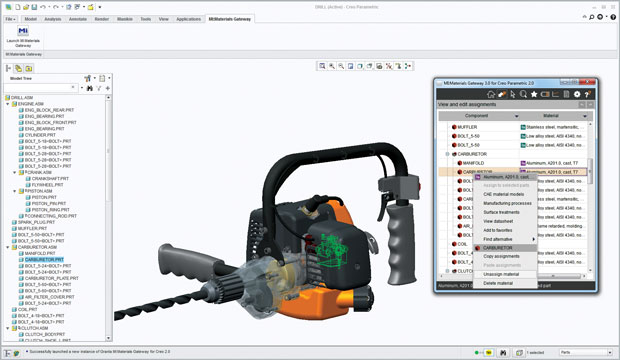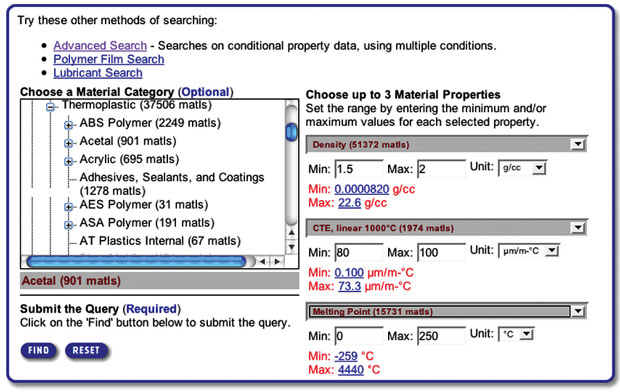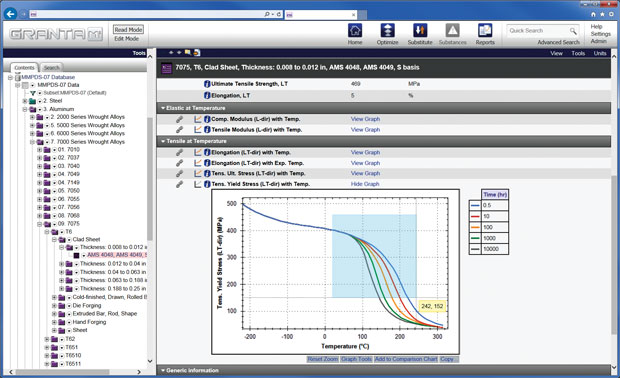
Accessing materials property data from a corporate materials database (the window on the right) within PTC Creo CAD, through the Granta Materials Gateway. Image courtesy of Granta Design.
Latest News
October 1, 2015
 Accessing materials property data from a corporate materials database (the window on the right) within PTC Creo CAD, through the Granta Materials Gateway.
Accessing materials property data from a corporate materials database (the window on the right) within PTC Creo CAD, through the Granta Materials Gateway.Image courtesy of Granta Design.
A full understanding of materials is crucial to product development, yet the decision to gather, store and use material data in a modern automated fashion has for the most part eluded the users of mainstream CAD/PLM/SCM technology. All of the software vendors that DE spoke with agree that most engineering companies, regardless of size, are still managing materials data using gathering, storage and retrieval methods from 15 years ago.
A modern, comprehensive solution to materials data management must address four key areas:
1. Research: materials R&D, testing, characterization, reports, certification and environmental impact.
2. Design: decision support data, reference data, purchasing specs, restriction and preference issues.
3. Production: materials quality assurance (QA), batch testing, comparison with specs and process improvement.
4. In-service and end-of-life: failure reports, empirical knowledge, cost reduction, aging and more.
In addition to the four key areas, material information is highly specialized in a variety of ways. This means more considerations like the following.
• Range and types of data: Testing, QA, research, mechanical/thermal/electrical properties, and more, plus various metadata (photos, videos, contextual information).
• Lifecycle: Materials information is needed from earliest conceptual to MBOM (manufacturing bill of materials) to mandated ethical and safety regulation reporting.
• Language: Materials classes and properties have their own conventions, units, measurements and subtleties.
• Mathematical models: Many properties are captured as mathematical models, such as stress/strain properties of an alloy and how they are affected by temperature and loading.
• Complex data management inter-relationships: Is the material data you need a standard, a company specification, or the subject of a recent simulation?
Material data touches both the technical and the business aspects of engineering. If engineering companies are to reap new efficiencies and make new discoveries about how to use materials, they must adopt new processes and build or buy the software to manage what can quickly become a mountain of data. Of the four disruptive IT technologies now on the scene (cloud, analytics, mobile and social), engineering is ripe for an analytics (Big Data) revolution of material data management.
A Material Data Public Challenge
The use of Big Data analysis has solved a variety of challenges in fields as diverse as astrophysics, biology and economics. U.S. Air Force Research Labs hopes to encourage similar breakthroughs in materials science with a public research challenge, now underway. Awards of between $5,000 and $25,000 will be given to researchers who can demonstrate “innovative approaches to solve materials science and engineering problems primarily through the analysis of publicly accessible digital data.”
The Materials Science and Engineering Data Challenge is particularly interested in discovery of new materials to meet an application need, and development of a new model describing processing-structure-property relationships for structural (load bearing), functional (electrical, optical or magnetic), or multifunctional material.
Emphasis will be on “use of existing and accessible data sources, novelty of the approach and validation of results.” The challenge opened to submissions in July 2015 and closes March 31, 2016.
MatWeb Online Material Property Data
Since 1996, MatWeb has offered both free and subscription-based access to material data. It now offers more than 110,000 data sheets for a wide variety of metals, plastics, ceramics and composites. Most of the data sheets are supplied by manufacturers and distributors. The online search engine allows combinations of keyword, material category, property ranges and composite ranges. An online weight and moment of inertia calculator is available to assist structural engineering inquires. A hardness converter can provide equivalence to multiple hardness scales.
 MatWeb provides a variety of online search tools for its database of more than 110,000 materials data sheets. Image courtesy of MatWeb.
MatWeb provides a variety of online search tools for its database of more than 110,000 materials data sheets. Image courtesy of MatWeb.As part of MatWeb’s fee services, data can be exported to the following formats:
• CSV and IQY for Excel
• Text
• SOLIDWORKS/CosmosWorks
• Autodesk Algor
• NEiWorks
• ANSYS
• COMSOL
• SpaceClaim
• ETBX (Engineer’s Toolbox)
Granta Design: One Part Database, One Part Specialist System
Granta Design has become an industry leader in software specific to materials data management. Founded as a research spin-out from Cambridge University, the UK-based Granta now excels in two areas: providing a central repository for materials science and engineering data and software for managing the information.
Much of the material information companies need to track is available as free or for-fee datasets. But this information usually needs to be combined with in-house data. An industry survey Granta conducted concluded at least 40% of material test data is used only once and then discarded. For a moderate-sized team, such loss and subsequent retesting could add up to $200,000 in time and resources, says Stephen Warde, vice president of Granta Design.
Any plan to tackle materials data management must take account of both the flow of information through the organization and the control of sensitive data. “In many organizations, access to materials data must be restricted to protect intellectual property or to comply with regulations such as ITAR [International Traffic in Arms Regulations],” says Warde.
Granta offers Granta MI, a database system designed to support material science and engineering. It considers the software as an adjunct to any existing PLM system in use. Granta works with the leading CAD and PLM vendors to create plug-ins allowing for simultaneous use of Granta MI and a CAD or PLM system, including Siemens NX CAD and Teamcenter PLM, Dassault Systèmes CATIA CAD and SIMULIA simulation management, and PTC Creo Parametric CAD and Windchill PLM.
Material Management at Lockheed Martin
In 2014, Renae Rippere of Lockheed Martin presented a public briefing in which she shared the results of implementing material data management. An internal audit revealed design teams were using a variety of sources and methods to obtain material data. There was very little data sharing, and there was a strong desire to improve documentation and traceability for previous material choices.
The Missiles and Fire Control division was already using Granta Design’s Granta MI for materials information management. A small team of material and process engineers were tasked with overseeing expansion of Granta technology into other divisions. The team started by developing a Preferred Materials list, to be linked to the company’s use of PTC Creo.
 A schematic view of the Granta MI system, similar to that implemented by Lockheed Martin. Image courtesy of Granta Design.
A schematic view of the Granta MI system, similar to that implemented by Lockheed Martin. Image courtesy of Granta Design.Lockheed Martin expected to gain efficiency from traceability; Rippere said the “best return on investment was the time savings” when engineers searched for material property data. The result was consistent use of a “solid modeling plug-in that provides vetted and consistent information to designers.”
From the experience at Lockheed Martin, Rippere noted five keys to successful implementation:
1. Management buy-in.
2. Early involvement of technical staff.
3. Wide availability of one-on-one discussions and demonstrations.
4. A trial discovery period before mandatory use.
5. Starting with a small set of materials (Lockheed Martin started with metals) to enable design teams to become familiar with the process.
Integrating Material Data into PLM
All of the major PLM vendors have modules to manage material data pertinent to sustainability and ethical compliance regulations. But the management of material sciences data for use in design is, generally speaking, a work in progress. Siemens PLM acquired material database technology in 2014 (Material Data Systems from ThinkStep) to beef up its abilities. It is now named “Teamcenter Integrated Materials Management” in their product list.
“Companies are scrambling to get a handle on sourcing of materials,” says Teddy West, product manager at Siemens PLM Software. “Designers need to see the material information, as well as the simulation and analysis information, all the way through. Materials touch every aspect of design.”
West says there is an important crossover efficiency from uniting materials data management with the central PLM system. “Our research shows 75% of materials come from supply chain components,” as opposed to internally developed parts. “We can help companies identify [materials] down to the substance level by gathering information from the supply chain,” he says.
West claims installation of Teamcenter Integrated Materials Management is a “trivial” process, but the larger issues of deployment varies widely. “Pulling all the data into Teamcenter can take a while depending on the complexities of the company.”
Keys to Developing a Material Data Management Strategy
As DE reported earlier this year (see “AutoMatIC Tackles Materials Data Challenge”), industry initiatives are underway to support the advancement of material data management. Aerospace and Defense has the Material Data Management Consortium; Automotive has AutoMatIC. Both organizations seek to increase productivity, lower costs, improve product performance, enhance regulatory compliance and deeply integrate material data into simulation and PLM.
For many companies, a thorough assessment of their material data management will reveal the existence of more of those dreaded “data silos” we’ve been hearing about for as long as PCs have been used for engineering. Whether you do the study internally or in partnership with a software vendor or an industry consortium, the goal should be to develop three balanced legs:
1. Strategies to manage internal material data.
2. Strategies to manage third-party data (from both specialty sources and supply chain sources).
3. Tools to access and use the information for decision support, design, simulation, and regulatory compliance.
More Info
Subscribe to our FREE magazine, FREE email newsletters or both!
Latest News
About the Author
Randall S. Newton is principal analyst at Consilia Vektor, covering engineering technology. He has been part of the computer graphics industry in a variety of roles since 1985.
Follow DE





